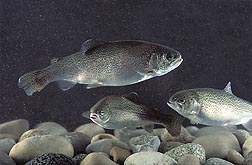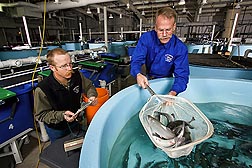Making a Barley Fish Feed Product
For centuries, barley has been used in beverages, soups, stews, breads, and other foods. It also has become a major component in livestock feeds for cattle, sheep, pigs, and other animals. But for fish, barley didn’t quite make the grade as a feed ingredient—until now.
The need to develop more plant-based protein sources for aquafeeds is increasing because the availability of small ocean fish, used to make fishmeal and other feeds, remains constant while demand increases dramatically. One of the challenges for fish-feed manufacturers is to procure ingredients that contain enough available protein to meet the dietary needs of fish.
A process that improves the nutritional value of barley has been developed by scientists at the Agricultural Research Service’s Small Grains and Potato Germplasm Research Unit in Aberdeen, Idaho, and Montana Microbial Products LLC (MMP) in Missoula, Montana.
“Barley feed grain typically contains about 10-12 percent protein, but an ingredient needs to contain 40-60 percent protein for carnivorous fish like rainbow trout,” says ARS fish physiologist Rick Barrows, who is stationed in Bozeman, Montana. “An enzymatic process was developed to concentrate the protein in barley by removing the carbohydrates, which are then turned into an ethanol coproduct, thus utilizing all the nutrients in the grain. The barley protein is not exposed to high temperatures during concentration, so its digestibility is very high.”
Scientists tested the barley protein concentrate in rainbow trout to determine its palatability and digestibility—the percentage of nutrients available to the fish. “Protein digestibility and amino acid availability were in the mid-90-percent range,” Barrows says.
|
|
Barley for Salmon
To evaluate the effects on growth in other fish, research leader William Wolters and fish physiologist Gary Burr, at the ARS National Cold Water Marine Aquaculture Center in Franklin, Maine, fed diets containing barley protein to Atlantic salmon—one of the most widely cultured species in the world. Most salmon diets are about 40 percent protein, scientists say. During a 4-month feeding trial, salmon were fed diets of either 11 percent or 22 percent barley protein concentrate. These fish were compared to salmon fed a standard commercial fishmeal diet. Wolters and Burr found no significant differences in growth among the three groups of fish. However, fish fed the diet containing 22 percent barley protein concentrate had significantly greater energy retention—34 percent—than the fish fed the other diets.
“Energy retention refers to how much energy we are putting into the fish and how much energy is staying in the fish,” Burr says. “Fish that have higher energy retention are using the feed more efficiently.”
This research, which was published online in the Journal of Applied Aquaculture in December 2013, showed that barley protein concentrate is a suitable feed ingredient for salmon and offers an alternative to the more expensive available sources, like fishmeal and soy protein concentrate. A recent collaborative study conducted at the University of Sterling in Scotland confirmed that barley protein is a nutritious feed ingredient for salmon, Wolters says.
Commercial Product Ahead
The barley-processing technology has been patented by ARS and MMP. The company received a license for the technology and recently built its first commercial prototype plant in Montana to produce the alternative fish-feed ingredient. The primary purpose is to produce barley protein for use in trout-feeding trials, says MMP’s Clifford Bradley.
“Our idea is to run this prototype plant for a year to 18 months and then build the first real commercial facility,” he adds. “The testing program will tell us how big we should build the first facility for the commercial product and what the market is going to look like.”
That market could be huge, according to Bradley. Aquaculture is still growing very rapidly, so the demand for high-protein ingredients is increasing at a steady rate. Typically, high-protein ingredients are selling at about $1,200 a ton or more, while fishmeal is about $1,600 a ton.
“It’s potentially a multibillion-dollar market,” he adds.
Counting the Benefits
Besides being less expensive than other protein sources, barley protein concentrate offers other benefits. The phosphorus from bones and fins in fishmeal is not very digestible. “Most of the phosphorus from fishmeal goes into the water as a pollutant,” Bradley says. “Barley protein has much less phosphorus, but it is more digestible and better utilized by the fish.”
Barley protein concentrate adds to the toolbox of feed manufacturers, reduces cost, and gives farmers an alternative to fishmeal. It also creates additional markets for small-grain growers, Barrows says. For example, the new process is perfect for use with malting barley that is too high in protein, due to weather conditions or other factors, to sell to beer companies.
“We’re trying to develop plant-based ingredients for fish so we don’t have to rely on fishmeal from the ocean, which has reached its maximum harvestable level,” Barrows says. “This helps the environment. Also, if we could produce more fish in the United States with less costly, sustainable ingredients, the American consumer would ultimately benefit from a safe, abundant, and nutritious food source.”—By Sandra Avant, Agricultural Research Service Information Staff.
This research is part of Aquaculture, an ARS national program (#106) described at www.nps.ars.usda.gov.
Rick Barrows is in the USDA-ARS Small Grains and Potato Germplasm Research Unit, Fish Technology Center, 4050 Bridger Canyon Rd., Bozeman, MT 59715; (406) 994-9909.
William Wolters and Gary Burr are with the USDA-ARS National Cold Water Marine Aquaculture Center, 25 Salmon Farm Rd., Franklin, ME 04634; (207) 442-2713 [Wolters], (207) 442-2716 [Burr].
"Making a Barley Fish Feed Product" was published in the July 2014 issue of Agricultural Research magazine.








